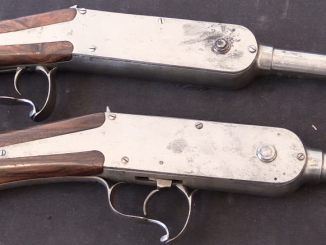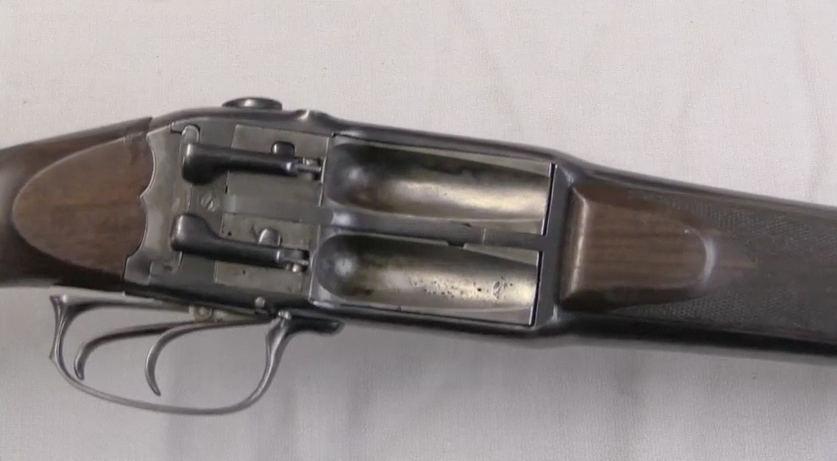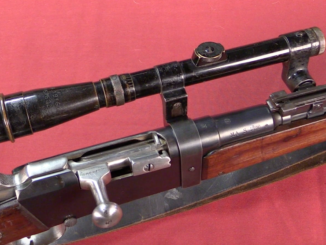“Union” was a trade name used by French and Spanish arms manufacturers (as well as American, actually) – but this particular Union is a French example. Among their many variations of pistols available (25, 32, long, short, extended barrels, etc) was a fully automatic version. For that pistol, they also developed a 35-round “horseshoe” magazine to provide maximum capacity without overly hampering the gun’s handling. These are extremely rare today, as not many were initially manufactured.
© 2025 Forgotten Weapons.
Site developed by Cardinal Acres Web Development.




High cap pimp gun. Needs a nickel finish and pearl stocks.
Fascinating.
Excellent presentation and very thorough.
Any chance the owner will allow you to do a video of you firing it?
Was this meant to be only a military pistol?
Thanks Ian.
No shooting it, unfortunately. I don’t think the extended mag was intended as a military thing…
The army would reject such a design. It’s way too “underpowered” for field operations and the magazine looks very difficult to produce…
Such weapons were probably mainly intended for police use. Remember that at that time, the 7.65mm Browning aka .32 ACP was considered the ideal police caliber in Europe. And increased firepower was a concern for even European police in the 1920s, due to the number of “war surplus” weapons that were floating around the Continent at the time.
There may also have been some interest in military sales, as well. During WW1, the Spanish Eibar makers did a land-office business selling cheap .32 ACP automatics to the perennially pistol-short French Army, which needed them badly for trench fighting. No, they weren’t .45s, .455s, or even .38s or 9mms, but then neither was the French M1892 St. Etienne 8mm service revolver, which was ballistically in the same ballpark as the .32 S&W (102 gr RNL @ 625 F/S for 104 FPE). Compared to it, the .32 ACP (71 grain @ 905 for 129 FPE) looks pretty good.
The combination of the .32 ACP, selective fire, and a 25-round magazine which could also function as a foregrip due to the “horseshoe” piece going around the underside of the forward frame, might have been intended as a “semi-off-the-shelf” response to the German Bergmann Muskete’. And it would certainly have been highly maneuverable in a trench, more so than even the short-barreled “machine carbine”.
Not a weapon I’d personally choose for such a mission, but if it was a choice between it and a “trench lance” (a four-foot long piece of 1″ wood tentpole with a bayonet attached), I’d tend to see it as better than nothing.
As Jeff Cooper said of the Star Model M in .45 ACP, I could always leave it on single-shot until I wanted to attract a lot of attention.
cheers
eon
Would the correct pronunciation of Union in French be Uwn-yawn? I know Onion is pronounced something like Own-yawn.
I see so many pre-WW2 back into the 1870’s French pistols stillwith magnificent factory finishes…I wonder if they had a secret formula?
Also just wanted to suggest that machine pistols have never really found their place in history, I presume due to the short recoil ridiculously high rate of fire. This has been the bane of police departments with high capacity semi-autos even today. The guns can fire much faster than one can pull the trigger and when one is Adrenalin pumped they can pull the trigger with significant speed resulting in both highly perforated target and rounds going all over the place.
This magazine would function as a nice handle for control purposes both in semi auto and full auto mode.
I would put it at something like “oon-yon”.
“I see so many pre-WW2 back into the 1870’s French pistols stillwith magnificent factory finishes…I wonder if they had a secret formula?”
I would bet: rust bluing after which firearm is resistant to rust/corrosion. Wikipedia entry Bluing (steel) explain that by fact that: “(rust bluing) converts any metal that is capable of rusting into magnetite (Fe3O4)”
It’s pronounced exactly like it is in English, just as “police” is. That’s because both were loan-words from French to begin with.
cheers
eon
Oddly enough I am having breakfast with an Algerian friend whose first language is English. Will be fun to see how he uses it. We are former co-workers and he speaks with a significant French accent.
First language is French, not English. 🙂
you can use this tool to listen how words are pronounced in many languages.
I tested it and it is accurate for the word “union” (I’m French).
http://www.acapela-group.com/?lang=fr
Sorry, I gave you the one in French…
Here is the english version : http://www.acapela-group.com/?lang=en
en-yown is how it sounded to me on the site, and this is pretty much how my Algerian Friend said it today.
Definitely does not sound like we in the US say “union”
Defenitely not the same, indeed.
Nevertheless, the “en-yown” phonetic is not that accurate. “Union” is pronounced with the “U” of the german word “über” and we do not pronounce the “N” at the end. “ON” in French does not sound like “O” then “N”, it is a diphtong wich is told like the “on” in “tong” (still without pronouncing the N).
The word ends abruptly. It is not “union-n” but “union/”.
My
Try any online translator. “Union” sounds (to an Ami ear) something like “in-yo.” A very short clipped “u” and the final “n” is silent as far as English ears go.
Now if I could come up with an effectively designed shoulder holster for this thing … Personally, I would like to see one of the select fire versions chambered for the .32 ACP round. My belief is if you can get enough lead into the air with some measure of accuracy it would still get the job done at close range. Well done again, Ian!
The old OSS horizontal spring-clip shoulder holster for the Colt M1903 should work. The “horseshoe” magazine would hang straight down, next to your ribcage. Drawing it would be the same as drawing the .32 Colt, rather like the later Galco “Miami Classic” or the “Mossad 3-way” in shoulder mode.
cheers
eon
Yes that is the big question: how to carry it comfortably.The other big question is how easily the magazine is to damage.It looks fragile. Yet a third question,how to fire from a prone position.
Would this magazine deliver every round to the chamber, or which one would jam? Nice simple hand gun though.
This magazine reminds me 100 round magazine for AK, see photo:
http://battletried.blogspot.com/2009/11/10-100.html
(6th and 7th photo from top), I can’t found information about its reliability. Notice that this magazine has “part of circle” shape when this for Union pistol has different (“horseshoe”) shape.
I am not expert on springs so I am asking: will spring work properly inside that shaped magazine?
The Steyr M1912, Russian Stechkin APS, Beretta Model 93R, The Micro Uzi, MAC-11, Steyr Tactical Machine Pistol and CZ-Scorpion have all been used with great success when used within their design parameters and many such as the Russian Stechkin APS have been called back into service mseveral times when the need arose. I have personally shot a modified (shortened) 9mm Jati on full-auto one-handed with an extended arm presentation and got all rounds into a man-sized silhouette target at 40 yards with no problem. This is not to neglect the Glock 19 with a 3-round burst limiter setting. Many so-called “machine Pistols” had these 2-3 round burst settings making them imminently controllable and useful in clearing rooms/buildings/bunkers/tunnels and etc, especially with an effective silencer/moderator attached. No one should use one in place of a smg when that is required, but they have in the past, do in the present and will into the future serve their limited but useful design purpose.
Was the outer end of magazine intended to be used as front grip? That would help stabilize the gun when shooting auto…
Great video as always!
Imagine you’d want to put some kind of sleeve over the ‘front curve’ of the magazine to prevent the spring being compressed but it does look like that would work doesn’t it?
I’m just amazed how practical it ends up seeming despite being so goofy looking.
Amazing! These are truly forgotten weapons.
Andrzej
Magnificent! To bad you couldn’t shoot that darlin’.
I wonder how a fully loaded magazine such as this would effect handling, vs one of the drum-type magazines currently made for Glocks, etc.
A very interesting and well made video!
There is a surviving exemplar of the pistol shown at the “Scientific Collection of Defence Engineering Specimens” (Wehrtechnische Studiensammlung) in Koblenz, Germany. I rembered that I had taken a picture of it when I had been there last year.
It is in good condition and also has an extended barrel like the one shown in the video. I tried translating some additional information from the little sign that was put next to it:
Union Selfloading Pistol
Manufacturer: Marcel Seytres, St. Etienne, France
Year of Manufacture: Unknown
Caliber: 7.65 mm, 6 grooves clockwise spin (rifling)
Barrel-lenght: 111 mm (extended barrel)
Velocity (ammunition): 290 m/s
Overall-lenght: 181 mm
Weight: 980 g
The horseshoe magazine was patended on 8. April 1930 under the number 693.501 in France.
Greetings from Germany!
Very interesting! How was this weapon carried or holstered? What was the best sequence of firing?
Thanks Ian
i have an article about it in an old (70s) french magazine.
some union pistols have a selector semi auto / full auto.
Just noticed you got picked up by Boing Boing.
I saw one the these pistol and magazine’s as a bring-back from WW2 and watched it being fired on full auto. They wouldn’t let the “kid” have a try though.
The reason from the extended barrel was to keep your support hand from sliding up the front of the magazine and shooting your fingers off.
Rate of fire as pretty fast, to a 12 year old, and there was some muzzle climb but it appeared to be manageable.
No, I have no idea where the pistol/magazine went after I saw it and all the others that were present have since passed away.
The Union is a quality version of the WW1 Ruby . The longer barrel would get more performance from the 7.65 x17 load which was loaded hotter than US or Belgian loads. The Ruby was widely used after WW1 in France. In the 1930s France wanted to adopt a new pistol and introduce a submachinegun.The Union was probably an attempt to provide a French made weapon to the tests. The magazines for the Union were usually 9 round Ruby type. The 35 round magazines actually work quite well. I own a semiauto only Union with the extended magazine. It handles much better than it would appear. I have been told the 35 round magazine was intended for the select fire version. These weapons and magazines are very well made.
It’s interesting to note that the final choices for the French Army’s service pistol (The M1935A, and its M1935S “war production” version) and SMG (the MAS-36) used the 7.65 x 20 round, which was basically the round of the experimental U.S. Pedersen Device of 1917. Its ballistics (85 gr. FMJ @ 1120 = 240 FPE) put it in the power class of the .38 Special, so it wasn’t exactly a weakling. (It showed better performance from a rifle-length barrel, which was after all what it had originally been intended for.)
Still, chambering a full-duty service pistol and your standard SMG for what was a basically a pocket pistol cartridge has to rank as one of the more dubious decisions ever made by a major army. Granted, it was more powerful than the Italian service rounds (.32 ACP, .380 ACP, and 9 x 9 Glisenti), but it wasn’t the Italian Army the French were expecting to have to fight.
Fierce French pride aside, they’d have done better to follow the lead of the Belgians, Poles, Finns, etc., and adopted the German 9 x 19mm. Which of course they did with the MAS 1950 pistol (a revised M1935S) and the MAT-49 SMG (One of the best of the early third-generation SMGS).
Ten years after getting their clocks cleaned by the Wehrmacht.
There’s a moral in there, somewhere, I’m sure of it…
cheers
eon
“85 gr. FMJ @ 1120 = 240 FPE”
It is close to Russian Nagant cartridge (7.62x38R) – 97 grains at 1070 fps
“and the MAT-49 SMG”
BTW, see Hotchkiss Type Universal if you want to see late 1940s attempt to build foldable sub-machine gun:
http://world.guns.ru/smg/fr/hotchkiss-universal-e.html
This gun proved be too expensive for more mass production and also time was needed to setup it from transport to combat mode
Two little errors in your post:
is MAS-36 should be MAS-38
is 9 x 9 should be 9×19
Congrats on making the frontpage of reddit Ian.
I believe that French law at that period allowed pistols of up to .32 calibre to be owned for self-defence, so that would explain why pistols such as the Union found a ready market, and also perhaps why French gun makers did not produce more powerful pistols.
For the most part defensive firearms were illegal in pre WW 2 France. People had 6.35 mm and 7.65 mm handguns but any “Military Calibers” were forbidden. France feared an internal Red revolution more than the return of the Huns. An effectively disarmed population ,France bled white by WW1 could not stomach another War. Many resistance groups had a “community gun” hidden for future use.
Considering the instability of the Third Republic you can understand their concern. Adding to their concerns the US had put France in a bind regarding WWI debts. US foreign policy in the past was not as prescient as it is today. Pun intended.
I wonder how well the rounds would transition through the curved portion of the magazine. It would seem that the ogives of the projectiles would be the only features in contact with one another, and that the rest of the cartridge would be unstable and “flop around,” leading to jams. I would be pleased to be proven wrong about that, however. It isn’t overly bulky and looks like it would lend itself to being carried easily in some sort of custom magazine-holder. Drums are cool but are difficult to store on your body.
If a policeman was assigned a vehicle of some sort, anything from a bicycle to a car, it would have been good as a second magazine. No reason to worry about bulk if carrying it in the vehicle. The high capacity of today’s “patrol rifle”, using the normal side arm. Anarchists holed up in a bank? Slip in this magazine before leaving the vehicle.
What would be the cost of this pistol now days? Good to Fair condition fully operational.